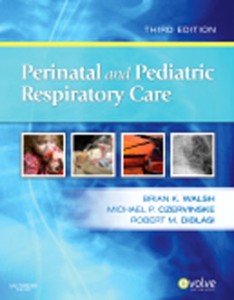Test Bank for Perinatal and Pediatric Respiratory Care, 3rd Edition: Walsh
$35.00 Original price was: $35.00.$26.50Current price is: $26.50.
Test Bank for Perinatal and Pediatric Respiratory Care, 3rd Edition: Walsh
This is completed downloadable of Test Bank for Perinatal and Pediatric Respiratory Care, 3rd Edition: Walsh

Product Details:
- ISBN-10 : 1416024484
- ISBN-13 : 978-1416024484
- Author: Walsh
With the in-depth coverage you need, this text helps you provide quality treatment for neonates, infants and pediatric patients. It discusses the principles of neonatal and pediatric respiratory care while emphasizing clinical application. Not only is this edition updated with the latest advances in perinatal and pediatric medicine, but it adds a new chapter on pediatric thoracic trauma plus new user-friendly features to simplify learning.
Table of Content:
Section I Fetal Development, Assessment, and Delivery
1(46)
Fetal lung development
1(12)
Bruce M. Schnapf
Scott M. Kirley
Stages of lung development
2(3)
Postnatal lung growth
5(2)
Factors affecting prenatal and postnatal lung growth
7(1)
Abnormal lung development
8(1)
Pulmonary hypoplasia
8(1)
Alveolar cell development and surfactant production
8(1)
Fetal lung liquid
9(4)
Fetal gas exchange and circulation
13(8)
Michael P. Czervinske
Maternal-fetal gas exchange
13(1)
Cardiovascular development
14(3)
Fetal circulation and fetal shunts
17(1)
Transition to extrauterine life
18(3)
Antenatal assessment and high-risk delivery
21(14)
Antoun Y. Khabbaz
J. Gerald Quirk
Maternal history and risk factors
21(5)
Antenatal assessment
26(2)
Intrapartum monitoring
28(1)
High-risk conditions
28(7)
Neonatal assessment and resuscitation
35(12)
Craig Patrick Black
Preparation
36(1)
Stabilizing the neonate
36(2)
Assessing the neonate
38(2)
Resuscitating the neonate
40(7)
Section II Assessment and Monitoring of the Neonatal and Pediatric Patient
47(100)
Examination and assessment of the neonatal patient
47(14)
Craig Patrick Black
Gestational age and size assessment
48(1)
Physical examination
49(8)
Neurologic assessment
57(1)
Laboratory assessment
57(4)
Examination and assessment of the pediatric patient
61(12)
Dennis E. Schellhaese
Patient history
61(2)
Pulmonary examination
63(5)
Nonpulmonary examination
68(1)
Laboratory testing
69(1)
The health care team
70(1)
Case studies
70(3)
Pulmonary function testing and bedside pulmonary mechanics
73(18)
Michael P. Czervinske
Michael A. Gentile
Definitions
74(1)
Special considerations
74(1)
Mechanics of breathing in newborns
75(1)
Neonatal pulmonary function testing in the laboratory
76(3)
Pediatric pulmonary function testing in the laboratory
79(4)
Measuring pulmonary mechanics at the bedside
83(4)
Summary
87(4)
Radiographic assessment
91(13)
J. David Ingram
Radiographic technique
91(1)
Normal chest anatomy
92(3)
Positioning of lines and tubes
95(1)
Airway obstruction
95(2)
Respiratory distress in the newborn
97(2)
Atelectasis
99(1)
Pneumonia
100(1)
Asthma
101(1)
Cystic fibrosis
101(1)
Acute respiratory distress syndrome
102(1)
Chest trauma
102(2)
Pediatric flexible bronchoscopy
104(12)
Karl Kalavantavanich
Craig M. Schramm
Indications
105(2)
Contraindications
107(1)
Equipment
107(1)
Preparation
108(3)
Procedure
111(1)
Postprocedural monitoring and complications
112(1)
Equipment maintenance
113(1)
Comparison with rigid bronchoscopy
113(3)
Invasive blood gas analysis and cardiovascular monitoring
116(21)
Robert M. DiBlasi
Michael P. Czervinske
Blood gas sampling
117(1)
Arterial puncture
118(2)
Capillary blood gas samples
120(2)
Arterial catheters
122(3)
Continuous invasive blood gas monitoring
125(1)
Central venous catheters
125(1)
Pulmonary artery catheterization
126(3)
Noninvasive measurement of cardiac output and perfusion
129(1)
Patient information
130(1)
Frequency
130(1)
Blood gas interpretation
130(3)
Abnormal hemoglobin
133(4)
Noninvasive monitoring in neonatal and pediatric care
137(10)
Cynthia Jacobus
Pulse oximetry
138(2)
Transcutaneous monitoring
140(1)
Capnometry
141(2)
Impedance pneumography
143(1)
Electrocardiography
144(1)
Calorimetry
144(3)
Section III Therapeutic Procedures for Treatment of Neonatal and Pediatric Disorders
147(314)
Oxygen administration
147(18)
Sherry L. Barnhart
Indications
148(1)
Complications
148(1)
Oxygen administration
149(16)
Aerosols and administration of medication
165(31)
James B. Fink
Bruce K. Rubin
Neonatal and pediatric medication delivery
166(1)
Aerosol administration in nonintubated infants and children
167(1)
Deposition in intubated infants
168(1)
Aerosal characteristics
168(2)
Aerosol delivery
170(10)
Device selection and compliance
180(1)
Emergency bronchodilator resuscitation
181(1)
Mechanical ventilation
182(4)
Bronchodilator administration
186(1)
Home care and monitoring compliance
187(1)
Other medications for aerosol delivery
188(2)
Summary
190(6)
Airway clearance techniques and lung volume expansion
196(24)
Brian K. Walsh
History and current status of airway clearance techniques
197(1)
Chest physical therapy techniques
197(4)
Chest physical therapy in the newborn
201(1)
Chest physical therapy in young children
201(4)
Complications of chest physical therapy
205(2)
Selection of patients for chest physical therapy
207(2)
Contraindications
209(1)
Length and frequency of therapy
209(1)
Therapy modification
209(1)
Monitoring during therapy
210(1)
Evaluation of therapy
210(1)
Documentation of therapy
210(1)
Incentive spirometry
210(3)
Intermittent positive-pressure breathing
213(2)
Future of airway clearance therapy
215(5)
Airway management
220(26)
Ian N. Jacobs
Mary M. Pettignano
Robert Pettignano
Intubation
221(3)
Intubation procedure
224(8)
Extubation
232(2)
Tracheotomy
234(8)
Suctioning
242(4)
Surfactant replacement therapy
246(21)
Santina A. Zanelli
David Kaufman
The discovery of surfactant
246(1)
Surfactant physiology
247(5)
Surfactant dysfunction in acute lung injury
252(1)
Clinical applications and replacement
253(8)
Future directions
261(6)
Mechanical ventilators
267(38)
Katherine Fedor
Ventilator classification
268(6)
Neonatal/infant critical care ventilators
274(4)
Universal neonatal/infant/pediatric/adult critical care ventilators
278(17)
Home care ventilators
295(7)
Summary
302(3)
Continuous positive airway pressure
305(20)
Robert M. DiBlasi
Peter Richardson
Indications
306(2)
Contraindications
308(1)
Hazards and complications
308(1)
Physiologic effects
308(1)
Delivery systems and patient interfaces
309(5)
Management strategies
314(4)
Advancing concepts
318(7)
Mechanical ventilation of the neonate and pediatric patient
325(28)
Brian K. Walsh
Robert M. DiBlasi
Objectives and indications for mechanical ventilation
326(1)
Types of mechanical ventilation
326(4)
Flow and pressure waveform patterns
330(1)
Time constants
331(1)
Triggering
331(1)
Modes of ventilation
332(3)
Managing ventilator settings
335(4)
Patient-ventilator interface
339(1)
Complications of mechanical ventilation
340(3)
Monitoring during mechanical ventilation
343(2)
Weaning from mechanical ventilation
345(2)
Advancing concepts
347(6)
Neonatal and pediatric high-frequency ventilation
353(20)
Keith S. Meredith
Mark Rogers
Definitions
354(1)
Mechanisms of gas exchange
355(3)
Indications
358(1)
Ventilator settings
359(1)
High-frequency ventilators on the U.S. market
360(2)
Ventilator management
362(1)
Clinical management strategies
363(2)
Weaning
365(2)
Care of the patient
367(1)
Circuits and humidification
367(1)
Troubleshooting
368(1)
Emerging clinical applications
368(5)
Noninvasive mechanical ventilation of the infant and child
373(11)
Pradip Kamat
W. Gerald Teague
Objectives of noninvasive ventilation
374(1)
Experience with NPPV in pediatric patients
375(2)
Noninvasive ventilation with positive-pressure devices
377(1)
Noninvasive ventilation with negative-pressure devices
378(1)
NPPV modes
378(1)
Monitoring the patient and ventilator circuit
379(1)
Pressure titration in noninvasive ventilation
379(1)
Interface selection and fit
380(1)
Complications and contraindications to NPPV
380(1)
Future of noninvasive ventilation
381(3)
Administration of gas mixtures
384(13)
Mark Rogers
Nitric oxide
385(4)
Helium-oxygen mixtures
389(2)
Hypoxic and hypercarbic gas mixtures
391(1)
Anesthetic mixtures
392(5)
Extracorporeal life support
397(20)
Douglas R. Hansell
History
398(1)
Neonatal treatment
399(3)
Pediatric treatment
402(1)
Extracorporeal physiology
402(4)
Extracorporeal life support circuit
406(4)
Cannulation
410(1)
Management and monitoring
411(2)
Weaning
413(1)
Decannulation
413(1)
Complications
413(4)
Pharmacology
417(22)
Robert G. Aucoin
&-Adrenergic agonists
418(5)
Anticholinergics
423(1)
Inhaled corticosteroids
424(3)
Systemic corticosteroids
427(1)
Leukotriene modifiers
427(2)
Methylxanthines
429(1)
Magnesium sulfate
430(1)
Nonsteroidal antiinflammatory drugs
430(1)
Mucolytic agents
431(1)
Ketamine
432(1)
Aerosolized antibiotics
433(1)
Antiviral agents
433(1)
Monoclonal anti-IgE antibody therapy
434(5)
Thoracic organ transplantation
439(12)
George B. Mallory, Jr.
Okan Elidemir
Marc G. Schecter
Heart transplantation
441(1)
Heart-lung transplantation
442(1)
Lung transplantation
442(1)
Immunosuppressive regimens
443(1)
Complications
444(4)
Role of the respiratory therapist
448(3)
Pediatric advanced life support
451(10)
Patrice Johnson
Kim Stevenson
Respiratory distress, respiratory failure, and respiratory arrest
451(1)
Shock and the relationship with respiratory failure
452(1)
Rapid cardiopulmonary assessment
452(1)
Initial assessment of appearance
453(1)
Initial assessment of airway/breathing
454(1)
Initial assessment of circulation
454(7)
Section IV Neonatal and Pediatric Disorders: Presentation, Diagnosis, and Treatment
461(270)
Neonatal pulmonary disorders
461(21)
Thomas L. Miller
Thomas H. Shaffer
Jay S. Greenspan
Respiratory distress syndrome
462(4)
Transient tachypnea of the newborn
466(1)
Neonatal pneumonia
467(3)
Meconium aspiration syndrome
470(3)
Persistent pulmonary hypertension of the newborn
473(2)
Apnea of prematurity
475(7)
Surgical disorders in childhood that affect respiratory care
482(16)
Scott Keckler
Kurt P. Schropp
Choanal atresia
483(1)
Macroglossia
483(1)
Mandibular hypoplasia
484(1)
Esophageal atresia and tracheoesophageal fistula
484(2)
Congenital diaphragmatic hernia
486(1)
Chest wall malformations
487(1)
Lung bud anomalies
488(5)
Gastroschisis/omphalocele
493(1)
Necrotizing enterocolitis
494(4)
Neonatal complications of respiratory care
498(19)
Charles L. Paxson, Jr.
Clinical presentations of chronic lung disease
499(2)
Diagnosis of chronic lung disease
501(1)
Pathophysiology
501(4)
Treatment of chronic lung disease
505(3)
Retinopathy of prematurity
508(1)
Intraventricular hemorrhage
509(8)
Congenital cardiac defects
517(26)
John Salyer
Teodor D. Butiu
David N. Crotwell
Cardiopulmonary anatomy and physiology
518(2)
Classification of cardiac anomalies
520(1)
Congenital cardiac anomalies
520(4)
Left ventricular outflow tract obstruction
524(13)
Clinical monitoring of patients with cardiac anomalies
537(1)
Respiratory care of patients with cardiac anomalies
538(5)
Sudden infant death syndrome and pediatric sleep disorders
543(11)
Pearl Yu
Normal control of brething and heart rate
545(1)
Etiology
545(1)
Tests to assess risk of sudden infant death syndrome
545(1)
Polysomnographic parameters
546(1)
Laboratory supervision
547(1)
Setting
548(1)
Personnel
548(1)
Normal sleep development
549(1)
Apnea
549(2)
Home cardiorespiratory monitors
551(3)
Pediatric airway disorders and parenchymal lung diseases
554(28)
Brian K. Walsh
Nico Vehse
The pediatric airway
555(1)
Airway obstruction
556(1)
Upper airway disorders
557(5)
Lower airway disorders
562(9)
Pneumonia
571(4)
Tuberculosis
575(2)
Sickle cell disease
577(1)
Recurrent aspiration syndrome
578(4)
Asthma
582(17)
Thomas J. Kallstrom
Maridee Jones
Pathogenesis of asthma
583(1)
Risk factors for development of asthma in children
584(1)
National asthma education and prevention program guidelines
585(1)
Diagnosis
586(1)
Management of asthma
587(7)
Managing asthma exacerbations in the emergency department
594(1)
Hospitalization and respiratory failure
595(1)
Exercise-induced bronchospasm
595(1)
Asthma at school
596(1)
Asthma camps
597(2)
Cystic fibrosis
599(12)
Bruce M. Schnapf
Genetics
600(1)
Diagnosis
601(1)
Pulmonary disease
602(2)
Treatment of pulmonary disease
604(2)
Other clinical manifestations
606(1)
Prognosis
607(4)
Acute respiratory distress syndrome
611(10)
Ira Cheifetz
Jennifer L. Turi
Definition
611(1)
Etiology
612(1)
Prevalence
612(1)
Clinical course
612(2)
Pathology and role of immunomodulators
614(1)
Pulmonary mechanics
615(1)
Treatment/ventilatory support
615(2)
Adjunct therapies
617(1)
Summary
618(3)
Shock and anaphylaxis
621(14)
Cynthia L. Gibson
Anthony D. Slonim
Shock
621(10)
Anaphylaxis
631(1)
Summary
632(3)
Sepsis and meningitis
635(8)
Julie Lynn Fitzgerald
Tracy Koogler
Sepsis
635(4)
Meningitis
639(1)
Summary
640(3)
Thermal and inhalation injury
643(11)
Ronald P. Mlcak
Thermal injury
643(3)
Inhalation injury
646(5)
Long-term outcomes
651(3)
Head injury and cerebral disorders
654(20)
Paul Mathews
Causes and anatomic considerations
655(1)
Initial assessment and diagnosis
656(3)
Stabilization
659(2)
Neurologic assessment
661(4)
Treatment plan
665(1)
Cerebral disorders
666(2)
Increased intracranial pressure
668(3)
Status epilepticus
671(3)
Thoracic truma in children
674(9)
Bradley M. Rodgers
Eugene D. McGahren
Birth trauma
674(1)
Blunt thoracic trauma
675(1)
Penetrating thoracic trauma
676(2)
Iatrogenic thoracic trauma
678(5)
Drowning in children
683(9)
Kristina H. Deeter
John K. McGuire
Incidence
684(1)
Pathophysiology
684(1)
Treatment
685(4)
Outcome
689(1)
Prevention
689(3)
Pediatric poisoning
692(14)
Kathleen D. Bongiovanni
Epidemiology
692(1)
General management
693(2)
Common poisoning agents
695(8)
Note on cough and cold preparations
703(3)
Disorders of the pleura
706(10)
Paul C. Stillwell
Pleural effusions
707(2)
Pneumothorax
709(1)
Thoracostomy drainage
710(3)
Surgery in the pleural space
713(3)
Neurologic and neuromuscular disorders
716(15)
Mary E. Hartman
Peter H. Michelson
Michael P. Czervinske
Neuromuscular control of respiration
717(1)
Neuromuscular diseases that affect the respiratory system
718(4)
Respiratory evaluation of children with neuromuscular disease
722(1)
Respiratory care of children with neuromuscular disease
723(4)
Transition to adulthood
727(4)
Section V Neonatal and Pediatric Transient and Ambulatory Care
731(30)
Transport of infants and children
731(9)
Garry Sitler
Team composition
732(1)
Modes of transportation
733(2)
Equipment
735(1)
Patient assessment and stabilization
736(1)
Advanced transport
737(1)
Safety of transport
738(1)
Accreditation
738(2)
Home care
740(21)
Sherry L. Barnhart
Discharge planning: the decision to go home
741(4)
Oxygen therapy at home
745(2)
Apnea-bradycardia monitors
747(2)
Pulse oximeters
749(1)
The child with a tracheostomy
749(5)
Mechanical ventilation in the home
754(4)
A successful transition home
758(3)
Credits
761(5)
Index
766
People Also Search:
perinatal and pediatric respiratory care
perinatal and pediatric respiratory care walsh
perinatal and pediatric respiratory care 3rd edition walsh
perinatal and pediatric respiratory care 3rd edition
perinatal and pediatric respiratory care 3rd edition download scribd
perinatal and pediatric respiratory care 3rd edition testbank download pdf
Related products
Test Bank
Test Bank for Essentials of Business Law and the Legal Environment, 11th Edition: Richard A. Mann











